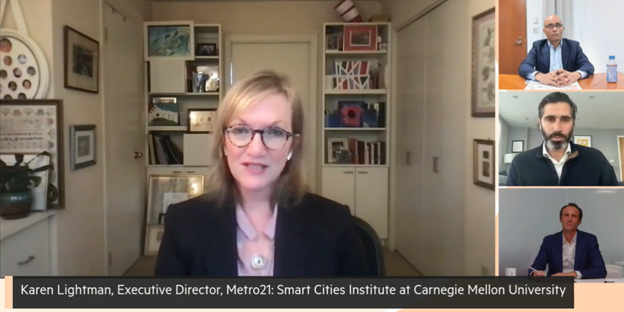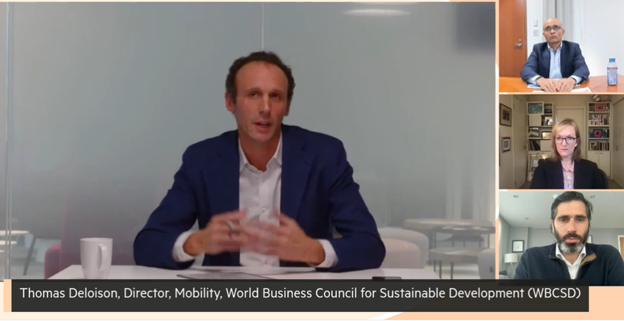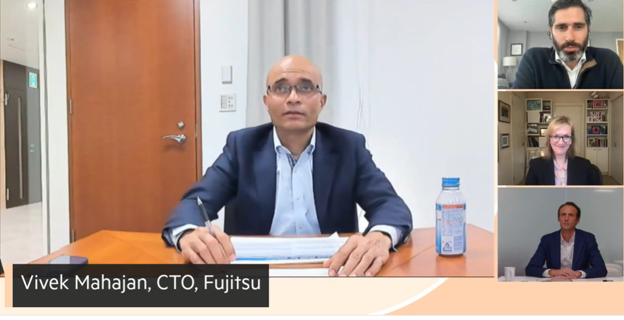
Sustainable Cities Innovation: Balancing Financial Priorities and Well-Being
This webinar hosted by the Financial Times, in partnership with Fujitsu Uvance will see speakers from the public and private sector discuss strategies for the decarbonisation of cities, with a focus on how technology can be used to create future sustainable cities that do not compromise on wellbeing in today’s volatile economic environment.
Karen Lightman, Executive Director, Metro21: Smart Cities Institute
-
6 years ago, we didn’t consider interoperability, privacy, security, policy, infrastructure – but there’s been a great awakening with the advancement of technology but it’s not equitable.
-
If we’re trying to be sustainable, we have to consider equity and diversity and a sense of community; tech is shiny and bright but then when we go to deploy the technology (PDD, robot, AV, etc), the issue isn’t the technology, it’s about the policies, the people, the interoperability
-
Metro21 has a broad definition of smart cities and sustainability; it’s very complicated and not easy; many companies define this state with Smart Planet (IBM) and they’ve had to rethink their strategies
-
Smart cities have evolved and is evolving and we have an opportunity to use technology as a tool, not as a guide; it’s really about problem solving
-
Google and their plans for Sidewalk Labs in Toronto was a flashpoint; they took a lot of heat for convos happening all over the world in the public realm; gave us an opportunity to learn to develop something integrated, more sustainable, more equitable
Thomas Deloison, Director, Mobility, World Business Council for Sustainable Development (WBCSD)
- We think as soon as tech is available it’s deployable but cities are enormous systems; Mayor of Lisbon said a day in a city is 10 years; if we try to deploy tech and think it will be immediate, that’s the pitfall companies are figuring out
-
There’s no tech useful if it’s not purposeful and isn’t serving people; they have to be inclusive (not everyone can afford every tech); it has to provide value, particularly in transport and during COVID where people were using sharing services to move away from public transit (how tech can serve people)
Vivek Mahajan, Chief Technology Officer, Fujitsu
-
You can’t have a strategy on sustainability without using tech extensively and having a digitalization strategy; you have policy, interoperability and at the end of the day, in a city, you have people – one plus one is not always two when you bring things into it other than machines
- At Fujitsu, there’s a lot of interest in using AI effectively in smaller realm because it’s data that doesn’t belong to only one enterprise; you can’t have a smart city based on only one business; to make a smarter city beyond the infrastructure, how do I get every citizen involved? What does it mean for me and my kids? They had a framework that said health points/environmental points, etc and run a city simulation to discover how much CO2 emissions and then get points to get rebates to cash in
- How to you get people involved who don’t have smartphones – if you want to make it a real solution, you have to think that through
What would the panel say are the four corners of sustainable city innovation? From what I've seen, for example contractual, governance and regulatory/auditing issues can be major pain points, and difficult to adjust to all stakeholders.
Karen: The smart city deployments we’re seeing now relate to mobility (transportation), some with respect to lighting (LED and smart lighting), some with air quality, and security-which is a touchpoint because it’s complicated. These are scaled and integrated but not always equitable. Through feedback through 311 and community feedback groups, there were shortcomings with SURTRAC that led to SURTRAC 2.0 to make it more citizen-friendly.
Thomas: tech can highlight what it can do vs. what the people need it to do. If there’s one pillar of the sustainable city innovation, for the strategy to be enabling but to be able to redefine the boundaries of how cities; purposeful; inclusive; sustainable. The highest potential of tech is when all tech is finding resonance with each other.
Vivek: to make tech inclusive, you have to have people who have different access to technology; you cannot make tech effective without co-creation – no single entity can do this alone
It seems the concept of Smart City is linked to a top down approach i.e. tech companies choose solutions on behalf of citizens. What tools could be designed to coach citizens towards more sustainable behaviors and to receive from them feedback to adapt and improve the technology itself?
Jacopo: an exec state bicycles are the least capitalistic people on earth because they don’t buy cars, don’t go to the gas station, etc – but it turns out a bicycle can be an incredible mean of transportation and super sustainable. What is the role that tech can play not only in introducing new solutions but also to empower existing habits that are already sustainable?
Thomas: if the policy requirements and tech infrastructure is in place, people can empower themselves and use it for a better purpose.
Karen: there’s this theme of transparency; in the US, paving is power – the use of tech has been able to shine a light and show communities weren’t ready to call 311 to report a pothole because there was a lack of trust but if it was equitably surveyed and transparently showing the roads it helps leaders to engage the public to use the tech and enable them to have access to the information to build trust in the community; looking at infrastructure, there’s a great opportunity if you have transparent availability of the information you can build the trust in the community
How are you making technology sustainable by design at Fujitsu?
Vivek: from a sustainability perspective, we’ve defined a purpose – Innovation. Trust. Sustainability. You can’t build innovation without technology. We want to change the entire organization structure – how tech is delivered to the customers – based on themes around sustainability (healthy living, trusted society). The tech at Fujitsu that builds that – it costs us more to build something that consumes less power in the short term but we believe it’s good business in the long run. We are building products that reduce power consumption, despite higher costs.
Thomas: Every company has to realize their impact on climate, nature, equity and start to change the portfolio (your activity or products you sell) by collaborating along the value chains; you also need to report and every effort you take has to be visible to the financial community and is already rewarding companies that are more sustainable.
Do you think cities should stop using the term ‘smart cities’?
Karen: Absolutely - we need to redefine the ‘smart’ in smart cities – it’s about transparency, people and problem solving – not the technology. People first.


